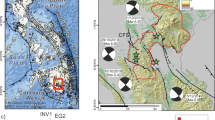Abstract
We employ a realistic finite-extent “k -2” stochastic source model with k-dependent rise time, introduced by Bernard et al. (1996) and extended by Gallovič and Brokešová (2004), to synthesize the strong ground motions in near source distances. For a given magnitude, this rupture model involves a number of free parameters (fault dimensions, slip roughness, maximum rise time, slip velocity function). We study their influence on the peak ground acceleration (PGA) maps (parametric study) for an example of the 1999 Athens earthquake of M w = 5.9. The observed macroseismic intensities serve us as a rough constraint on the simulated PGA's to find a set of suitable k -2 models. These models agree with empirical source scaling relations.
Similar content being viewed by others
References
Aki K., 1967. Scaling law of seismic spectrum. J. Geophys. Res., 72, 1217–1231.
Aki K. and Richards P.G., 1980. Quantitative Seismology: Theory and Methods. W.H. Freeman, San Francisco, USA.
Baumont D., Courboulex F., Scotti O., Melis N. S. and Stavrakakis G., 2002. Slip Distribution of the Mw = 5.9, 1999 Athens earthquake inverted from regional seismological data. Geophys. Res. Lett., 29, Art. No.1720.
Berge-Thierry C., Bernard P. and Herrero A., 2001. Simulating strong ground motion with the “k-2” kinematic source model: an application to the seismic hazard in the Erzincan basin, Turkey. J. Seismol., 5, 85–100.
Bernard P. and Herrero A., 1994. Slip heterogeneity, body-wave spectra, and directivity of earthquake ruptures. Ann. Geofis., XXXVII, 1679–1690.
Bernard P., Herrero A. and Berge C., 1996. Modeling directivity of heterogeneous earthquake ruptures. Bull. Seismol. Soc. Amer., 86, 1149–1160.
Brokešová J., 1993. High-Frequency Ground Motions due to Extended Seismic Sources in Complex Structures. PhD. Thesis, Charles University, Prague.
Brune J., 1970. Tectonic stress and the spectra of seismic shear waves from earthquakes. J. Geophys. Res., 75, 4997–5009.
Emolo A. and Zollo A., 2001. Accelerometric radiation simulation for the September 26, 1997 Umbria-Marche (Central Italy) main shocks. Ann. Geofis., 44, 605–617.
Gallovič F. and Brokešová J., 2004. On strong ground motion synthesis with k-2 slip distributions. J. Seismol., 8, 211–224.
Gasperini P., 2001. The attenuation of seismic intensity in Italy: a bilinear shape indicates the dominance of deep phases at epicentral distances longer than 45 km. Bull. Seismol. Soc. Amer., 91, 1–15.
Hanks T.C., 1982. FMAX. Bull. Seismol. Soc. Amer., 72, 1867–1879.
Herrero A. and Bernard P., 1994. A kinematic self-similar rupture process for earthquakes. Bull. Seismol. Soc. Amer., 84, 1216–1228.
Hisada Y., 2000. A theoretical omega-square model considering the spatial variation in slip and rupture velocity. Bull. Seismol. Soc. Amer., 90, 387–400.
Joyner W., 1991. Directivity for nonuniform ruptures. Bull. Seismol. Soc. Amer., 81, 1391–1395.
Louvari E. and Kiratzi A., 2001. Source parameters of the 7 September 1999 Athens (Greece) earthquake based on teleseismic data. J. Balkan Geophys. Soc., 4, 51–60.
Mai M. and Beroza C., 2000. Source scaling properties from finite-fault rupture models. Bull. Seismol. Soc. Amer., 90, 604–615.
Novotný O., Zahradník J. and Tselentis G.A., 2001. Northwestern Turkey earthquakes and the crustal structure inferred from surface waves observed in Western Greece. Bull. Seismol. Soc. Amer., 91, 875–879.
Papadopoulos G.A., Drakatos G., Papanastassiou D., Kalogeras I. and Stavrakakis G., 2000. Preliminary results about the catastrophic earthquake of 7 September 1999 in Athens, Greece. Seism. Res. Lett., 71, 318–329.
Plicka V. and Zahradník J., 2002. Inversion of rupture nucleation from regional records by egf method for unequal focal mechanisms of the mainshock and aftershock: The Athens 1999 earthquake. Tectonophysics, 359, 81–95.
Sargeant S.L., Burton P.W., Douglas A. and Evans J.R., 2000. A source model for the 7th September 1999 Athens earthquake. Proceedings, European Seismological Commission (ESC), XXVII General Assembly, Lisbon, Portugal, September 10–15, 138–142.
Somerville P., Irikura K., Graves R., Sawada S., Wald D., Abrahamson N., Kagawa Y.I.T., Smith N. and Kowada A., 1999. Characterizing crustal earthquake slip models for the prediction of strong ground motion. Seism. Res. Lett., 70, 59–80.
Tselentis G.A. and Zahradník J., 2000a. The Athens earthquake of 7 September 1999. Bull. Seismol.Soc. Amer., 90, 1143–1160.
Tselentis G.A. and Zahradník J., 2000b. Aftershock monitoring of the Athens earthquake of 7 September 1999. Seism. Res. Lett., 71, 330–340.
Wessel P. and Smith W.H.F., 1991. Free software helps map and display data. EOS Trans., 72, 445–446.
Willmore P.L., 1979. Manual of Seismological Observatory Practice. Report SE20, World Data Center A for Solid Earth Geophysics, Boulder, Colorado, USA.
Zahradník J., 2002. Focal Mechanism of the Athens 1999 Earthquake by ASPO Method. Res.Report, Dept. of Geophysics, Faculty of Math. and Phys., Charles University, Prague, Czech Republic (http://seis30.karlov.mff.cuni.cz).
Zahradník J. and Tselentis G.A., 2002. Modeling strong-motion accelerograms by “PEXT” method, application to the Athens 1999 earthquake. Proceedings, European Seismological Commission (ESC), XXVIII General assembly, Genoa, Italy, September 1-6, CDROM.
Zollo A., Bobbio A., Emolo A., Herrero A. and De Natale G., 1997, Modeling of ground acceleration in the near source range: the case of 1976, Friuli earthquake (M = 6.5), Northern Italy. J. Seismol., 1, 305–319.
Author information
Authors and Affiliations
Rights and permissions
About this article
Cite this article
Gallovič, F., Brokešová, J. The k-2 Rupture Model Parametric Study: Example of the 1999 Athens Earthquake. Studia Geophysica et Geodaetica 48, 589–613 (2004). https://doi.org/10.1023/B:SGEG.0000037473.70906.08
Published:
Issue Date:
DOI: https://doi.org/10.1023/B:SGEG.0000037473.70906.08




